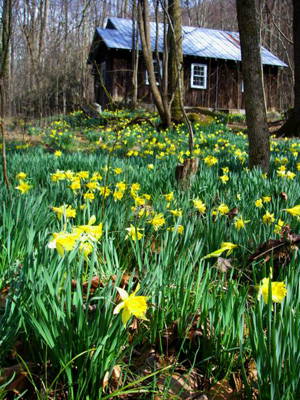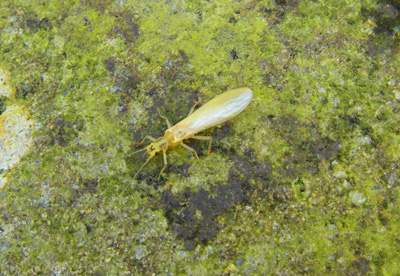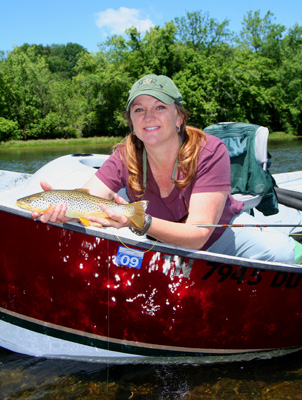
Hang in there! Spring is coming soon!
It’s still winter but many of us are already planning our fishing in the months ahead. We get numerous emails and phone calls over the winter from people planning trips. Many of those folks are trying to hit a particular hatch, good flows on the tailwaters, or the best conditions for an extended backcountry fishing trip.
February There’s not usually a whole lot going on in during the heart of winter, but you can get out on the water more than you might think. Focus you attention on the tailwaters for the best action. It’s been a long winter with little to no tailwater fishing depending on the exact river, but TVA should begin to moderate generation by February. The South Holston and Watauga Rivers always have the most consistent schedules for fishing, but look for the Clinch, Holston, and Hiwassee to get good.

Fat rainbows can be caught on the Clinch and Holston in the late winter
The South Holston is the head of the heap for dry fly fishing with great Blue Wing Olive hatches. Also bring some midge patterns along with a few Sulphurs. The Clinch can have some superb midge fishing in the winter. Try some sowbug patterns if the midges aren’t hatching.
Most of the streams in the Smokies will fish slow. Abrams Creek in Cades Cove usually fishes better than most other streams because it has warmer water temperatures from numerous springs that feed it. Delayed Harvest streams like Paint Creek and Tellico River in Tennessee and the Nantahala and Tuckaseegee Rivers in North Carolina are also good bets in the winter.
Periodic mid-winter “thaws” can provide some very good fishing on all waters. Warm, sunny days will get midges hatching on the tailwaters and fish in the mountain streams will become more active as well. Some years spring weather can arrive by the last week of February.
March is really when spring fishing kicks off in the Smoky Mountain region. Fishing on the tailwaters can be good, but dry fly fishing on many of the creeks can be nothing short of phenomenal. Quill Gordons and Blue Quills are mayflies that hatch on the larger streams and bring trout to the surface.

This brown trout was rising to Quill Gordons on Little River
Little River, Deep Creek, the Oconaluftee River, and Bradley Fork have some of the best dry fly fishing in the Smokies during March. These hatches can start as early as the first of the month or as late as the 15th. Bugs will start hatching between 11:00 AM and 1:00 PM and may linger up until 3:00 PM or later.
One thing to be aware of in 2010 is that Cades Cove will be closed March through May while the road is re-paved. This means no fishing on Abrams Creek this spring.
Midge fishing is usually pretty good on the Holston and Clinch Rivers in March. There might be a few caddis on the Holston to whet your appetite for the coming months, but focus your efforts on fishing nymphs. Small Woolly Buggers can also be quite effective in the spring. Bring them across riffles with an erratic retrieve for the best results.
April is when things start to heat up all over. Fishing starts to pick up on all the tailwater rivers and the streams in the Smoky Mountains only get better. The Clinch, Holston, and Hiwassee Rivers are all usually on a “pulse” generation schedule. This is a minimum flow schedule when flows are generally low and generators will give occasional pulses of water to keep water flowing. Caddis usually hatch on the Hiwassee and Holston while Sulphurs start to hatch on the Clinch.
In the Smokies the trout will be rising very well and certainly eating nymphs when they’re not. Quill Gordons will begin to fade from the scene but they are replaced by Hendricksons and March Browns. The yellow mayflies start to hatch by the end of April. Light Cahills and Sulphurs hatch late in the afternoon into the evening.
Watch for Yellow Sallies to start hatching by mid-April but the real action with these bugs happens later in the month when they lay eggs on the water just before dark.

Yellow Sally stonefly
May is one of the best all round months for fly fishing in East Tennessee and western North Carolina. Fishing is excellent in the Smokies at all elevations. Hatches are well under way on the tailwaters and smallmouth bass are also active on the rivers.
Light colored mayflies and stoneflies come out in the evenings on Smoky Mountain trout streams. The caddis hatch on the Holston River can be downright ridiculous at times and the Sulphurs usually have trout rising on the Clinch. Dry fly fishing is certainly part of the experience no matter where you fish for trout, but don’t leave the nymph box at home.

Charity hooked this brown trout on a dry fly
Nymphs are often required on the tailwaters in the hours leading up to a hatch. They continue to work well during a hatch, but who can fish a nymph when trout are rising to the surface? May is usually our best month for dry fly fishing on the Holston River. Caddis hatches can get crazy at times!
May is also the best month for Sulphurs on the Clinch. Last year was the best Sulphur hatch we’ve seen in a long time and we’re hoping for a repeat in 2010!

bob keene says
How does the Oconaluftee fish in mid -late May. Any good spots around Whittier?
Ian says
The Oconaluftee, like a lot of Smokies streams fishes great in May. Whittier is pretty far downstream for trout. You’re beginning to get into smallmouth country that close to the Tuckaseegee. The bulk of trout in the river through Cherokee are stockers, but the stream inside the park is an excellent wild fishery. You should also check out Deep Creek in the park near Bryson City.
Louis Martin says
see ya there come may!!!!